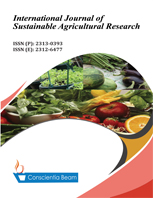Dynamics of structural indices and organic carbon pool across a haplic acrisol under secondary tropical rainforest at Umudike Abia State
DOI:
https://doi.org/10.18488/ijsar.v11i3.3870Abstract
Differences in vegetation types over a landscape influences the structural behaviour and organic carbon pool of soils thereby affecting site-specific management decisions. This study aimed at establishing the differences in structural indices and organic carbon pool across a soil under secondary rainforest vegetation. Nine replicates of auger and core soil samples were randomly collected from the site at 0 – 20 cm depth. Soil samples were prepared and analysed at a laboratory. Data obtained were subjected to geospatial analysis using a Geographical Information System (GIS) software package. Results showed that changes in organic carbon storage ranged from 40 – 48 ton / ha, BD ranged from 1.39 – 1.42 mg / m3, clay flocculation index ranged from 50 – 68 %, aggregated silt + clay ranged from 9 – 12 %, clay dispersion index ranged from 32 – 42 %, dispersion ratio ranged from 26 – 32 %, mean weight diameter ranged from 0.75 – 1.05 mm, saturated hydraulic conductivity ranged from 3.1 – 3.8 cm / mins and total porosity ranged from 46.4 – 47.6 %. Regions of weak micro aggregaion dominated the land while regions of increased stability of macro aggregates were dominant. Regions of increased soil organic carbon storage occupied about half portion of the land. Greater portion of the land was noted for increased bulk density, reduced total porosity and saturated hydraulic conductivity. Consequently, there were changes in soil structural properties and organic carbon storage across the studied area.

